

Arizona monsoon: What is a haboob? Dust storms can be some of the most dramatic weather events we see in the Valley each year.
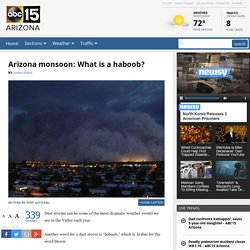
Another word for a dust storm is “haboob,” which is Arabic for the word blown. Haboobs are giant walls of dust created from high winds rushing out of a collapsing thunderstorm. Cold air in front of the storm rushes down at an incredible rate, picking up massive amounts of dust and sand and blowing them into the air. As the dust storm builds, it can completely block out the sun, making it nearly impossible to see just a few feet in front of you. The wall of dust typically reaches heights between 1,500 and 3,000 feet and can stretch as far as 100 miles wide. However, the Valley has seen dust storms that are even bigger. If you get caught outside during a dust storm, seek shelter immediately or you may be hurt by flying rocks and debris being thrown around by winds up to 50 mph. The effects of dust storms can linger for days, worsening our air quality and causing many people difficulty breathing. About The Dust Bowl. Encyclopedia Britannica.
What is a Haboob? - Weather Glossary. Your eyes are not deceiving you.
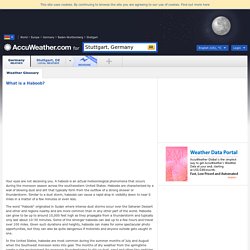
A haboob is an actual meteorological phenomena that occurs during the monsoon season across the southwestern United States. Haboobs are characterized by a wall of blowing dust and dirt that typically form from the outflow of a strong shower or thunderstorm. Similar to a dust storm, haboobs can cause a rapid drop in visibility down to near 0 miles in a matter of a few minutes or even less. The word "Haboob" originated in Sudan where intense dust storms occur over the Saharan Dessert and other arid regions nearby and are more common than in any other part of the world. Haboobs can grow to be up to around 10,000 feet high as they propagate from a thunderstorm and typically only last about 10-30 minutes. All About Dust Bowl - Easy Science For Kids.
When the first settlers crossed the American plains in the mid-to-late 1800s, the vast landscape must have seemed endless.

So much fertile land to be ranched or farmed. Although being a farmer or rancher was hard work, it was a satisfying way of life for many people. In the 1920s, grain prices dropped and many farmers had to farm more land just to earn as much money as they had before. Farmers throughout the Midwest stripped the prairie-lands to make more farms.
Some people warned that the land couldn’t remain fertile if it was used this way. What is a haboob? A wall of dust, hundreds of feet high, rolled into the Phoenix area with gusts of wind up to 62 mph on Monday evening.
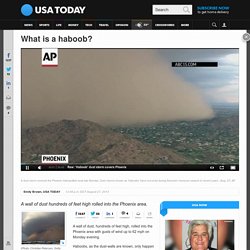
Haboobs, as the dust-walls are known, only happen in Arizona, the Sahara desert and parts of the Middle East because of dry conditions and large amounts of sand, weather officials say. The storms are known to halt airline flights, knock out power and turn swimming pools into mud pits. Monday's haboob was part of a massive monsoon storm that downed trees and power lines, flooded roadways and left nearly 14,000 customers without power. With a little over a month left before the official end of Arizona's monsoon season, storms like Monday's aren't unusual, but this one was much more widespread than others this summer, according to an official with the National Weather Service in Phoenix. Haboobs - HowStuffWorks. Haboobs are the temper-tantrum-prone siblings in the dust storm family.

They're relatively small compared to the massive storms that are caused by synoptic-scale systems, but they tend to erupt out of nowhere and with dramatic fanfare. They're common in the Sudan and North America, namely the Southwest plains. As we just found out, they're associated with thunderstorm activity.
What is a drought? What is a drought?
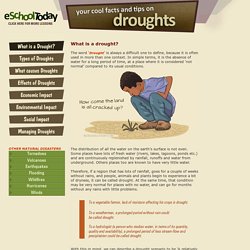
The word ‘Drought’ is always a difficult one to define, because it is often used in more than one context. In simple terms, it is the absence of water for a long period of time, at a place where it is considered ‘not normal’ compared to its usual conditions. The distribution of all the water on the earth’s surface is not even. Some places have lots of fresh water (rivers, lakes, lagoons, ponds etc.) and are continuously replenished by rainfall, runoffs and water from underground. Others places too are known to have very little water. Therefore, if a region that has lots of rainfall, goes for a couple of weeks without rains, and people, animals and plants begin to experience a bit of dryness, it can be called drought. Massive HABOOBS Will Blow You Away (PHOTOS) “I’ve always had a passion for the weather, ever since I was a little kid watching the monsoon thunderstorms with my dad,” explained photographer Mike Olbinski, whose striking photos of haboobs, an intense dust storm, in Arizona’s arid climate capture Mother Nature’s greatness.
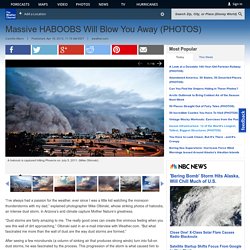
“Dust storms are fairly amazing to me. The really good ones can create this ominous feeling when you see this wall of dirt approaching,” Olbinski said in an e-mail interview with Weather.com. Haboob.